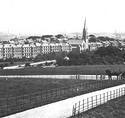 Crosshill emerged as a residential south-side suburb from the 1850s. Although not then formally part of the city, the community owed its creation to Glasgow Corporation, which in 1857 had purchased the extensive farmlands of Pathhead for use as a public park. Property speculation featured as a prime rationale for laying out Queen's Park as the municipal landowners hoped to benefit from the construction of quality housing in its immediate vicinity.
Crosshill emerged as a residential south-side suburb from the 1850s. Although not then formally part of the city, the community owed its creation to Glasgow Corporation, which in 1857 had purchased the extensive farmlands of Pathhead for use as a public park. Property speculation featured as a prime rationale for laying out Queen's Park as the municipal landowners hoped to benefit from the construction of quality housing in its immediate vicinity.
 Crosshill developed quickly and soon became a favoured residence for middle-class commuters. Victoria Road led from the city to Queen's Park Gates and by 1875 a regular tramway service was operating along the route. Although Glasgow's town councillors maintained a keen interest in the progress of the suburb they were constantly frustrated in their efforts to annex it to the city. The burden of Glasgow taxes did not appeal to Crosshill residents, but politics also lay behind local moves in 1871 to elect the district into a self-governing police burgh. Crosshill was in Renfrewshire and its votes were important to help maintain the Liberal majority in the county constituency. It was thus crucial, for electoral purposes, to keep it separate from Glasgow.
Crosshill developed quickly and soon became a favoured residence for middle-class commuters. Victoria Road led from the city to Queen's Park Gates and by 1875 a regular tramway service was operating along the route. Although Glasgow's town councillors maintained a keen interest in the progress of the suburb they were constantly frustrated in their efforts to annex it to the city. The burden of Glasgow taxes did not appeal to Crosshill residents, but politics also lay behind local moves in 1871 to elect the district into a self-governing police burgh. Crosshill was in Renfrewshire and its votes were important to help maintain the Liberal majority in the county constituency. It was thus crucial, for electoral purposes, to keep it separate from Glasgow.
 In 1871 Crosshill's population was less than 2,300 and at thirty-three hectares it was the smallest of the nine police burghs that were encircling Glasgow by 1880. It nevertheless boasted some striking architecture, notably the French-inspired tenements by William Whyte, erected in the mid-1880s at Balmoral Crescent. However, Crosshill's distinctive civic identity came to an end in 1891 when Glasgow succeeded in persuading the inhabitants that it was in their interests to combine with the city. There was no longer the political incentive to protect county interests, while the inauguration of the Cathcart District Railway in the 1880s had drawn Crosshill closer to Glasgow.
In 1871 Crosshill's population was less than 2,300 and at thirty-three hectares it was the smallest of the nine police burghs that were encircling Glasgow by 1880. It nevertheless boasted some striking architecture, notably the French-inspired tenements by William Whyte, erected in the mid-1880s at Balmoral Crescent. However, Crosshill's distinctive civic identity came to an end in 1891 when Glasgow succeeded in persuading the inhabitants that it was in their interests to combine with the city. There was no longer the political incentive to protect county interests, while the inauguration of the Cathcart District Railway in the 1880s had drawn Crosshill closer to Glasgow.